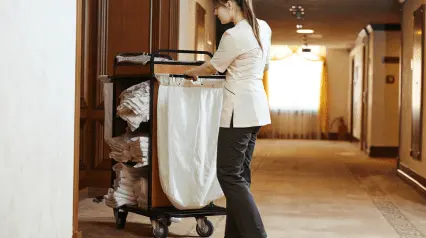What is Restaurant Maintenance?
Restaurant maintenance is the umbrella term used for activities that are necessary to prolong the upkeep of equipment, assets, and infrastructure in a commercial dining environment. It typically includes restaurant cleaning, facility disinfecting, routine kitchen equipment maintenance, proper waste handling, and monitoring assets.
Importance
Maintenance is important in the restaurant industry, as it ensures a safe, clean, and efficient dining environment. A well-maintained restaurant reduces the risk of accidents such as slips, trips, and falls, while also preventing noncompliance with food safety and food handling standards. In line with this, the Centers for Disease Control and Prevention (CDC) cites that well-maintained equipment is a key factor in practicing safe food handling.
Functioning equipment is able to store food at the right temperature, preventing spoilage and food pests from contaminating inventory. Moreover, routine maintenance extends the lifespan of costly equipment and restaurant interior, preventing unexpected breakdowns that could disrupt operations and lead to financial losses.
6 Common Restaurant Maintenance Strategies
Effective restaurant maintenance strategies help ensure smooth operations, safety, and customer satisfaction. Here are some commonly implemented strategies:
Regular Cleaning and Sanitization
Regular cleaning and sanitization in restaurant maintenance involve the routine removal of dirt, grease, and food residue from surfaces, equipment, and dining areas to ensure a hygienic environment. This process includes daily cleaning of kitchen counters, cooking appliances, floors, restrooms, and dining tables, as well as deep cleaning on a scheduled basis.
Maintaining the cleanliness of a restaurant food contamination, pest infestations, unpleasant odors, and the buildup of grease that can lead to fire hazards. Additionally, maintaining cleanliness enhances the restaurant’s reputation, improves customer experience, and ensures a safe workplace for employees.
Create your own restaurant cleaning checklist
Scheduled Equipment Maintenance
Scheduled equipment maintenance in a restaurant involves regular inspections, servicing, and repairs of equipment used within operations. This typically includes kitchen appliances, HVAC systems, and refrigeration units. This proactive approach helps prevent unexpected breakdowns, extends the lifespan of costly machinery, and ensures smooth operations.
As a form of preventive maintenance, it also prevents equipment malfunctions, inefficient energy usage, food spoilage due to refrigeration failure, and fire hazards from poorly maintained cooking equipment. This helps restaurants avoid costly repairs and operational disruptions from happening.
Pest Control Management
Pest control management is the process of implementing measures to prevent, monitor, and eliminate pests such as rodents, cockroaches, and flies that can contaminate food and create health hazards. Common methods for this include sealing entry points, maintaining cleanliness, properly storing food, and scheduling regular inspections with pest control professionals.
Proper pest control is a crucial component of food safety and restaurant reputation management. Without pest control, restaurants risk unsafe food that loses customer trust and goes against health code violations.
Plumbing and Electrical Checks
Plumbing and electrical checks in restaurant maintenance involve the regular inspection, repair, and upkeep of water lines, drainage systems, wiring, and electrical equipment to ensure safe and efficient operations. Proper plumbing maintenance prevents issues such as leaks, clogged drains, and water contamination, while electrical checks help avoid power failures, faulty wiring, and fire hazards.
Floor and Furniture Maintenance
Floor and furniture maintenance involves regularly inspecting, cleaning, and repairing flooring, tables, chairs, and other furnishings used in a restaurant. This includes addressing scratches, cracks, loose fixtures, and slippery surfaces to prevent accidents and drive up the restaurant’s aesthetic appeal.
Additionally, providing guests with ergonomic furniture and a comfortable and appealing interior helps maintain a welcoming atmosphere to ensure a positive dining experience.
Fire Safety Compliance
Fire safety compliance in restaurant maintenance involves adhering to fire prevention regulations by regularly inspecting and maintaining fire extinguishers, smoke detectors, sprinkler systems, and emergency exits. It also includes proper ventilation, grease trap cleaning, and safe handling of flammable materials to minimize fire risks.
Failure to comply with fire safety regulations can result in fines, operational shutdowns, or devastating fires that put lives at risk. By prioritizing fire safety compliance, restaurants can protect their staff, customers, and property while ensuring smooth and secure operations.
Best Practices for Restaurant Maintenance
Effective restaurant maintenance is essential for ensuring a clean, safe, and efficient operation. Here are some tips and best practices to follow:
- Create a Maintenance Schedule: Establish a routine for cleaning, equipment inspections, and repairs to prevent unexpected breakdowns and ensure compliance with health and safety regulations. Use digital tools to streamline scheduling and automate reminders to achieve consistent maintenance completion.
- Use a Digital Maintenance Log: Keep track of completed maintenance tasks and upcoming repairs to stay organized and address issues promptly.
- Monitor Maintenance Performance: Use data analytics to track how often maintenance goals are met and to identify any recurring issues based on submitted reports. Highlight areas for improvement to ensure the restaurant is well-maintained.
- Train Staff on Maintenance Procedures: Educate employees on proper cleaning techniques, equipment handling, and emergency protocols to maintain a high standard of safety and hygiene.
- Work with Professional Services: Enlist the services of certified technicians for specialized maintenance tasks, such as HVAC servicing, pest control, and fire safety inspections.



